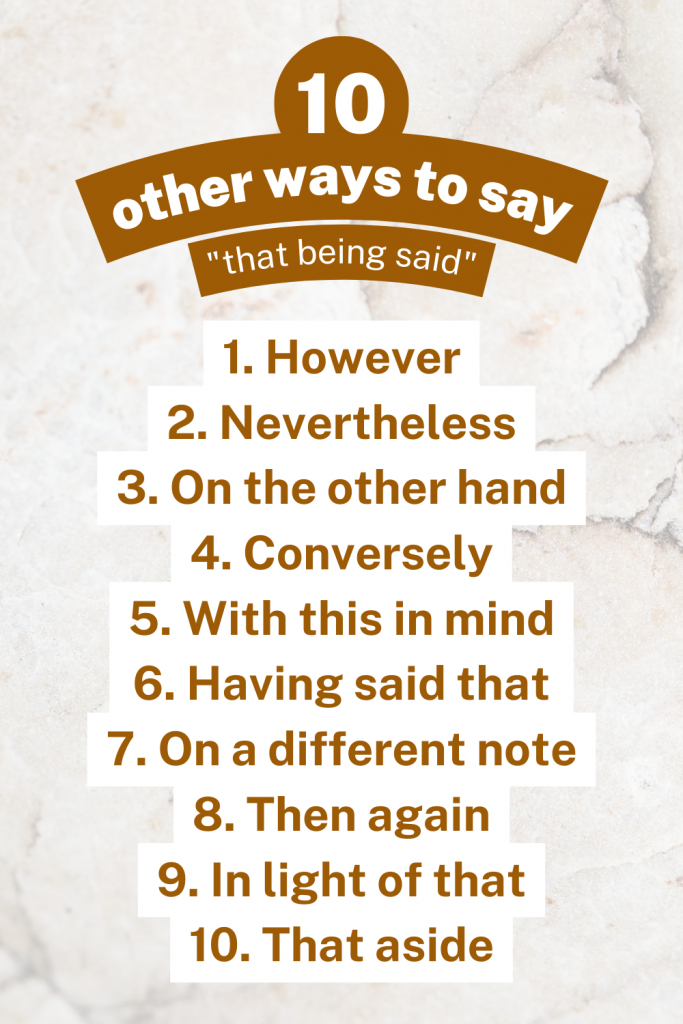People tend to say “that being said” when they chat. It’s a great transition that allows you to jump from one thing to another. It’s like saying Yes, I hear you, but also peep this. . . We want to highlight some spicy alternatives so we can spice up the way we speak. This article explores other ways of switching between ideas that paint more of a picture than just what is repeated over and over.
Alternatives to “That Being Said”
Transitional Expressions
When we talk or write, transitional phrases connect our thoughts, taking readers from one idea to the next. They’re like bridges in a conversation. Besides “that being said”, here are some other ones that work:
1. However
Example: “The movie was critically acclaimed. However, I found it quite boring.”
Usage: “However” is probably the most common and can work in anything from school essays to office memos. It gets the basic point across without seeming too stiff.
2. Nevertheless
Example: “The task was challenging. Nevertheless, they completed it on time.”
Usage: “Nevertheless” is sort of a fancy version of “however”. It works if you’re trying to sound more academic or professional. It puts extra emphasis on the shift you’re making.
3. On the other hand
Example: “The car is expensive. On the other hand, it’s very reliable.”
Usage: This phrase is super useful if you’re making a counter-argument or discussing different opinions. It clearly shows you’re about to say something that contrasts with what came before.
4. Conversely
Example: “Some argue that technology simplifies life. Conversely, others believe it makes life more complicated.”
Usage: “Conversely” is great for when you stated something earlier and now want to make a conclusion based on it. It signals you’re about to wrap up your persuasive case.
5. With this in mind
Example: “Global temperatures are rising. With this in mind, we should reduce carbon emissions.”
Usage: In arguments and formal writing this phrase smoothly handles transitions where you are changing gears or contrasting thoughts.
More Casual
More casual settings or creative writing let you play with phrases like these. They make nice bridges between ideas when you want to sound less stiff.
1. Having said that
Example: “He’s not very punctual. Having said that, he’s an excellent worker.”
Usage: This is a great phrase to transition topics during a chat or in informal writing. It’s great for gently changing the subject or bringing up something totally new.
2. On a different note
Example: “We’ve discussed the budget cuts. On a different note, let’s talk about the upcoming team event.”
Usage: This expression adds a bit of hmm, but maybe. . . when you want to toss out another idea without being too harsh.
3. Then again
Example: “It’s supposed to rain tomorrow. Then again, the weather is often unpredictable.”
Usage: “Then again” works for summing things up before making a choice about what to do next.
4. In light of that
Example: “The company has been profitable this year. In light of that, bonuses will be distributed.”
Usage: It’s good for briefly going through something and then jumping to the next thing you want to talk about.
5. That aside
Example: “The project has some minor issues. That aside, it’s progressing well.”
Usage: It’s useful when you’ve made a point and need to switch gears, like if you’re giving a casual presentation and want to move on.
When to Use Different Expressions
Formal or Academic Settings
In environments that demand a high level of formality, such as academic papers, business reports, or professional meetings, it’s essential to use transitions that reflect seriousness and clarity.
Opt For: “However,” “nevertheless,” and “conversely” are excellent choices in these scenarios. They are formal and convey a clear shift in thought, making them ideal for structured and serious discourse.
Example Usage:
“However” can introduce a contrasting point in a research paper.
“Nevertheless” is suitable for presenting a counterargument in a debate.
“Conversely” works well when discussing opposite viewpoints in a business report.
Casual Conversations
In less formal settings, like chatting with friends, casual business meetings, or everyday conversations, a more relaxed tone is usually preferable.
Opt For: “Having said that” or “then again” are perfect for these situations. They maintain the conversational flow without sounding overly formal.
Example Usage:
“Having said that” can smoothly transition between points in a friendly debate.
“Then again” is ideal for introducing a playful counterpoint or speculative thought in a conversation.
Creative Writing
When it comes to creative expression, such as in storytelling, poetry, or scriptwriting, the choice of transitional phrases can significantly influence the style and voice of the piece.
Opt For: “On a different note” or “in light of that” are great choices for adding a creative twist or stylistic uniqueness to your writing.
Example Usage:
“On a different note” is excellent for shifting scenes or topics in a novel or screenplay.
“In light of that” can be used to draw conclusions or highlight a revelation in a poem or story.
Public Speaking or Presentations
In public speaking or formal presentations, where maintaining audience engagement is key, the right transitional phrase can make a big difference.
Opt For: Phrases like “with this in mind” or “that aside” are effective. They help in maintaining the audience’s focus and smoothly transitioning between different segments of your talk.
Example Usage:
“With this in mind” can be used to connect the dots or lead to a conclusion after presenting facts or statistics.
“That aside” works well for briefly acknowledging a side point before returning to the main topic of the presentation.

Conclusion
So in conclusion, “that being said” is a handy little transition that people often use when speaking or writing to connect one thought to the next. It works well and gets the job done, but it’s quite informal. If you’re writing a research paper or giving a big presentation, things like however or despite may sound more professional. But when you’re just chatting with friends or trying to keep things light, saying this or then again can make you sound more casual and relaxed.
FAQs Related to the Phrase “That Being Said”
1. Is “that being said” grammatically correct?
Yes, “that being said” is grammatically correct. It is a transitional phrase used to pivot from one idea to another, often introducing a contrast or a related but different point of view.
2. Can “that being said” be used in formal settings?
While “that being said” is grammatically correct, it is generally considered less formal. In formal writing or speech, alternatives like “however,” “nevertheless,” or “conversely” are often preferred as they are more formal in tone.
3. When should one avoid using “that being said”?
Avoid using “that being said” in very formal or academic writing, where a more formal transitional phrase would be more appropriate. Additionally, it should not be overused in any context, as this can make the text or speech repetitive and less impactful.
4. Is there a difference in meaning between “that being said” and its alternatives?
While “that being said” and its alternatives generally serve the same purpose of transitioning between ideas, they can carry slightly different connotations. For example, “nevertheless” often implies a stronger contrast or opposition to the preceding statement than “that being said.”
5. Can “that being said” be used at the beginning of a sentence?
Yes, “that being said” is commonly used at the beginning of a sentence to introduce a contrasting or supplementary statement to what has been previously mentioned.
6. Is “that being said” appropriate in casual conversation?
Yes, “that being said” is quite suitable for casual conversations. It’s a conversational phrase that helps in transitioning between thoughts or introducing a contrasting viewpoint.









